Compact Equipment magazine has published a detailed list of recommended service actions for specified service intervals on compact loaders:
- Daily service
- Service per shift
- 50 hours
- 100 hours
- 250 hours
Based on factory recommendations provided by HCMA, the article was first published in Compact Equipment’s issue of September, 2021. Read the full article here
- Hitachi Construction Machinery and Deere are dissolving their joint venture.
- Hitachi Construction Machinery Americas Inc. (HCMA) will become the regional headquarters for the Americas for all Hitachi construction machinery products and services.
- HCMA plans to significantly expand its scope of products and services in the Americas, strengthen its dealer network, grow the use of “uptime” and IoT functionality on jobsites and aggressively pursue mining market opportunities.
Hitachi Construction Machinery (HCM) and Deere have announced plans to dissolve their joint venture in the Americas. The dissolution will be completed February 28, 2022.
At the same time, HCM is announcing that HCMA will assume all product and service operations for the Americas in Spring 2022. HCMA will continue to be a wholly owned subsidiary of the Hitachi Construction Machinery Group.
HCMA is planning to add more than 60 new local positions to strengthen its North American headquarters in Newnan, Georgia.
Masaaki Hirose, Chairman and HCM executive officer, will continue to be responsible for HCMA. Alan Quinn, who currently serves as CEO, will continue in the same role.
“HCM, through HCMA, will be able to better determine its own destiny in the Americas with its own business strategies, improved products and services, and updated technologies, all provided through a revamped and strengthened distribution network,” Quinn said.
Beginning Spring of 2022, HCMA will introduce new equipment to the Americas with cutting-edge technologies that increase efficiency and safety while lowering total cost of ownership. The company plans to differentiate itself through the product capabilities of these new machines, including the latest in hydraulic systems, innovative “uptime” and IoT services, and advanced safety features. It will also assess the potential for completely new products that meet the needs of the Americas markets.
HCMA will be able to structure its business to respond to market changes and fulfill the evolving needs of equipment owners and operators. In construction, price competition for new machinery from emerging countries is intensifying and demands for improvement in safety and efficiency on job sites are becoming stricter. In mining, competition for hydraulic excavators and dump trucks used in mines has intensified as the global trend to reduce CO2 through automation, unmanned and electrification has increased. In after-sales service, the development of “uptime” services is also growing.
“HCM has been improving and investing in business strategies since 2017 to prepare for the creation of HCMA,” Quinn said. “This includes many ‘value chain’ initiatives to bolster parts and service, rental, used equipment, remanufactured parts and financing. It has also been improving technologies in analytics, IoT, telematics, fleet management and uptime services. In the future, HCMA will be able to better utilize these advances to capture more market share.”
In the short term, all wheel loaders, excavators and mining equipment will be manufactured in Japan. HCM and HCMA will continue to evaluate this supply structure for the future to evaluate the possibilities for production in the Americas.
Future growth
One of HCMA’s main strategies will be to increase the usage of ConSite globally. The company will extend the service to new Hitachi brand excavators and continue to expand its use in mining. The goal is to increase the use of telematics and predictive analytics to increase uptime on the jobsite.
HCMA’s other goals include:
- Strengthen its regional headquarters in the Americas
- Formulate new market strategies
- Rebuild and strengthen its distribution network in North America
- Respond to increased demand from mining and civil engineering for safer equipment that is more productive and reduces total lifecycle costs
- Promote sustainable initiatives for manufacturing, construction and mining; reduce dependence on coal-related businesses, reduce CO2 emissions
- Continue to aggressively expand into mining, particularly in Latin America
- Steadily establish parts service bases
- Expand rental and used equipment businesses
“We are very excited to begin this new chapter as HCMA,” Quinn said. “We have an ambitious plan for the future, and we are focused on dynamically responding to the needs of our customers and the quickly changing nature of the equipment market.”
 FOCUS magazine, first published in 2003, was inspired by a team of Kawasaki dealer personnel, satisfied customers and an eager Kawasaki marketing team who wanted to bring compelling stories, tips and industry news to wheel loader users throughout North America. Fifteen years later, our goals remain the same, our focus renewed with the global vision of Hitachi.
FOCUS magazine, first published in 2003, was inspired by a team of Kawasaki dealer personnel, satisfied customers and an eager Kawasaki marketing team who wanted to bring compelling stories, tips and industry news to wheel loader users throughout North America. Fifteen years later, our goals remain the same, our focus renewed with the global vision of Hitachi.
Black Kow compost is one of America’s most successful brands in garden centers. Michael Lange of Black Gold Compost explains how Hitachi loaders, and Kawasaki machines before that, have been essential to his process from start to finish. Read more.
Larry Larson, owner of Larson Topsoil in Central Florida, added two Hitachi ZW50s to his fleet to help his crowded yard load even the tallest haul trucks efficiently. Operators love the closed cab, climate control and better visibility of the wheel loaders. Read more.
Pasco Iron & Metal wanted to spare its operators the shower of aluminum shavings that come from loading aluminum turnings with a skid steer. They made the decision with the Hitachi ZW50 compact loader to not only protect the operator away, but to reduce operating costs. Read more.
When Taylor-Cade Trees needs a wheel loader to dig up 5-year-old live oak trees and load them onto their trucks, they rely on the power and dependability of the Hitachi ZW80 to tackle the heaviest jobs. Read more.
CLICK HERE TO DOWNLOAD A PDF OF THE HITACHI FOCUS MAGAZINE, SUMMER 2021 EDITION
Using everything from greenhouses and garden shears to a pair of six-ton loaders with massive Hitachi machinery attachments, this company in central Florida grows landscaping trees big and small.
As a helper in his father’s vegetable farm, Stoney Maddox has had his hands in the soil growing plants since as far back as he can remember.
In 1999 he acquired nine acres and started a tree farm business in Bevilles Corner, Florida.
From those humble beginnings, he’s grown his business to encompass more than 100 acres.
Taylor-Cade Trees (named after his children) nurtures trees from the seeds in a greenhouse up to mature specimens planted in the ground and harvested after five years. Selling to nurseries and frontline landscapers, the company offers everything from containerized trees and shrubs to ground-planted trees upward of 10 to 20 feet tall. Live oaks are his most popular product, but he sells plenty of magnolias and evergreens as well.
With large greenhouses and planted trees stretching to the horizon, Maddox is a busy man. “We have 34 employees and planting goes on year-round,” he says. As a wholesale distributor the company sells north of 300,000 trees a year. Taylor-Cade Trees is family owned and operated. Maddox’s wife, Lori, does the company payroll while he mostly takes care of the work in the fields and greenhouses.
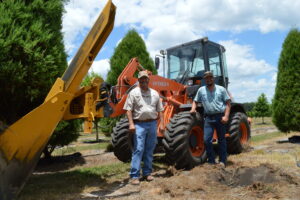 Maddox’s employees plant seedlings and containers six days a week, sometimes seven. Planting and harvesting the more mature trees with Hitachi machinery attachments usually takes place in the winter when there is less stress on the trees. But there’s no real off season.
Maddox’s employees plant seedlings and containers six days a week, sometimes seven. Planting and harvesting the more mature trees with Hitachi machinery attachments usually takes place in the winter when there is less stress on the trees. But there’s no real off season.
While in the containers the trees grow 6 to 10 feet tall. To keep these container-bound trees from blowing over in a storm, they’re lashed to a long line of cable. But when hurricanes threaten, it’s all hands-on deck as crews scramble to untie the cables and lay these hundreds of valuable and vulnerable trees on the ground.
Maddox says he occasionally forces himself to take a few days off to go fishing or hunting, but even then, in the back of his mind, he says he’s always thinking about his trees.
Starting with seed
In the Taylor-Cade greenhouses, thousands of seeds growing in trays must be maintained at precise temperatures and moisture levels around the clock until they’re ready to transfer into containers. Depending on the species, the temperature, moisture, and soil medium in which they’re growing vary by subtle amounts. There’s a lot of science to it, but Maddox is beyond science. After all these years, he’s turned it into an art.
From starting the seedlings to pruning, there is a huge amount of hand work that goes into a tree farm like Taylor-Cade. But with more than 100 acres in play they need machinery as well. The company’s fleet consists of an aerial lift, trucks, sprayers and a dozen or so utility tractors.
That’s enough to keep mechanic Brett Anderson busy year-round. But the workhorses and newest machines in his fleet are two recently acquired Hitachi ZW80 wheel loaders, both with Hitachi machinery attachments that see about 500 hours a year.
Stoney chose the Hitachis in large part because for years he had run the precursor to the Hitachi ZW80, the TCM loader. “Except for our old TCM, we’ve never had anything other than the Hitachis. They’re bullet proof,” Maddox says. Taylor-Cade operators run the loaders to clean up, build burn piles and move pallets. But the most critical application performed by the ZW80s is powering a tree spade to dig up the mature trees and load them onto trucks.
Valuable commodities
Once the containerized trees are planted in the ground and begin growing, crews work through the rows and carefully prune them several times a season to make sure the leaves or needles get a full measure of sunshine, and the trunks grow as straight as possible. As you might imagine with all the time and work that goes into them, these planted trees are Taylor-Cade’s most valuable commodities.
Live oaks are even more in demand this year. After winter ice and single-digit temperatures killed vast numbers of trees in Texas, the call for trees heading west has been unprecedented, Maddox says.
 Reaping the reward
Reaping the reward
After three to five years in the ground, it’s time to harvest. And Maddox is not about to roll into his carefully manicured fields with anything less than a stable, dependable, low-impact machine.
The harvest starts with a tree spade attached to custom made boom on the bucket attachment plate of the ZW80 loaders. Auxiliary hydraulics open the spade as it is centered on the trunk. Once in position, three long triangular blades are driven down into the ground, cutting a conical shaped hole three feet deep around the root ball.
Cradled in the Hitachi machinery attachment, the tree and root ball are lifted out of the ground. The hole is then lined with a poly sheet and wire mesh, and then the tree and root ball are placed back into the hole. Over the next few months, the roots grow through the wire and poly, which stabilize the root ball. Crews then return with the loader and spade, dig up the tree again and place the whole bundle — tree, root ball, with wire and poly intact — into a truck for transport.
Stability is safety
With the weight of a tree spade and a five-year-old live-oak on the end of the boom, machine stability is an important factor for Maddox. Unlike most loaders which mount the rear wheels rigid to the frame, the Hitachis have an axle that pivots in the middle around the differential, same as a truck axle. That makes the machine more stable on sloped and uneven ground.
And while Taylor-Cade’s fields are flat and meticulously maintained, the risk of a tire slipping into a hole is not zero. A loader with wheels mounted to the frame in these circumstances might easily tip over, especially carrying a heavy load held high. With Hitachi’s oscillating axle, the loader is more stable on uneven ground.
“Except for our old TCM, we’ve never had anything other than the Hitachis. They’re bullet proof”
– Stoney Maddox, owner of Taylor-Cade Trees
Maddox says the loader might get stuck in a hole, but it’s much less likely to tip over. “That’s a good safety feature they have on those machines that a lot of other loaders do not offer,” he says. And it’s no less important than when the load it’s carrying is the culmination of five years’ worth of work.
Some tree farms use spades mounted on skid steers or compact track loaders to extract their trees. But Maddox prefers the wheel loader and the Hitachi machinery attachments. The visibility is better and CTLs and skid steers, no matter how carefully you operate them, tear up the ground. Maddox keeps a neat carpet of grass growing throughout his fields. The wheel loaders are heavy, but by virtue of their big tires and articulated steering, they won’t disturb the grass. And as long as there is grass in the rows, the mud and runoff created by rains is minimal. That’s no small thing in coastal Florida.
Something old, something new
Maddox bought his first Hitachi branded ZW80 when he found out that the company that made the TCM loaders was acquired by Hitachi. “I called the number that was on the old TCM machine and found out they no longer made them,” he says. But the same company that sold the TCMs, Great Southern Equipment, also sold Hitachis. Salesman Steve Tuton trailered one to the tree farm and worked out a deal.
“Steve and Great Southern Equipment have been good to work with. I’ve never even been to their dealership, but they send the filters and service items to our locations and take good care of us,” Maddox says.
Pasco Iron and Metal’s Successful Switch to a Hitachi Compact Wheel Loader
Pasco Iron and Metal switched from a skid steer to a Hitachi ZW50 compact wheel loader to create a cleaner, safer, and more productive work environment.
After learning the trade from his father, Matt Goldman started Pasco Iron & Metal in 2007 with just three employees. Today the Land O’ Lakes, Florida, company has grown to employ 50 people. Across its two locations, Pasco operates a fleet of nine trucks, six cranes and five skid steer loaders. Crushers and processing equipment bang away at mountains of incoming and outgoing scrap metal all day long.
“We have two full-time mechanics and one full-time welder and could use two more mechanics,” Goldman says. “But having control over our transportation gives us an advantage over most of our competition. We pay a little bit more for maintenance and service, but that control adds value. And the customers love the service.”
Recycling big time
Pasco recycles a wide variety of metals including iron, stainless steel, aluminum, copper, nickel, brass, and lead. Along with their second location in Largo, they buy old appliances, radiators, batteries, wire, circuit boards, aluminum shavings and all sorts of industrial size lots of scrap metal. The material is dumped in the yard and then processed, typically crushed, or melted into ingots and then sold to companies that will use it to make new products.
In 2013 the company added a railroad spur and started leasing rail cars to deliver large shipments of scrap iron to the ports and other rail terminals. On an annual basis, Pasco Iron and Metal ships 40,000 tons of steel and iron, the equivalent of 500 rail cars. Nonferrous shipments, copper and aluminum primarily, run about 24 million pounds a year.
Taking delivery of this material, processing it, and then loading it onto trucks and railcars and shipping it out again makes for a very busy yard. It’s kinetic, noisy, and nonstop.
Aluminum rain
One of the most challenging jobs in the company is loading aluminum turnings. These are fine strands of aluminum that come off lathes and milling machines, and Pasco regularly receives and processes tons of it. The problem is that when loading these turnings with a skid steer, the bucket is so close to the operator that he invariably gets littered with stray shavings as he dumps the bucket into a truck.
These shavings wind up accumulating in the operator’s lap and pile up so deep in the footwell of the cab that it becomes hard to work the pedals. Operators crawl out of the cab at the end of the day with hundreds of tiny bits of aluminum turnings clinging to their clothing and boots.
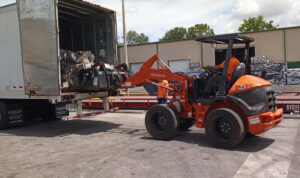 Better way to load
Better way to load
Pasco Iron and Metal decided to try a Hitachi ZW50 compact wheel loader, not only to keep the cab and operator away from the aluminum spillage, but to see how it competed against skid steers in terms of productivity and operating costs.
They didn’t have to look far. They already enjoyed a good relationship with Great Southern Equipment, the local Hitachi dealer, and had bought several cranes from them.
“We called Steve Tuton, our salesperson at GSE, and told him, ‘We know you sell these. What can you do for us?’” says Jimbo Jennings, operations and dispatch manager. “And we got it worked out. We didn’t even look at another one, because of what Steve had to offer.”
“The operator can see more around him on the ZW50. He can see where he is loading. And it has a bigger bucket and can handle more volume than a skid steer”
– Matt Goldman, founder of Pasco Iron and Metal
So far, Pasco operators have had just a few weeks on the Hitachi compact wheel loader, but they like it, Jennings says. With the longer wheelbase the bucket is far enough in front of the cab that stray shavings fall to the ground instead. “It’s working well for them,” he says. “Not only are the operators and the cab staying clean, but the compact wheel loader has a bit more power than the skid steers.”
Right-sizing the machine
Choosing the size of loader was something Pasco did debate. Hitachi offers one size smaller, a ZW30, and plenty of loaders larger than the ZW50. But the ZW50 met all the important criteria.
“The ZW50 isn’t that much bigger than the ZW30 but it has more power and lifting capacity,” Jennings says.
Visibility is another plus. “The operator can see more around him on the ZW50,” Goldman says. “He’s not in a box. He can see where he is loading. And it has a bigger bucket and can handle more volume than a skid steer.”
What’s more, Goldman wanted a machine that could withstand the rigors of the scrapyard. “That’s my biggest challenge,” he says. “We don’t want to be putting out maintenance fires all the time, he says. “If you have a machine down, you’re dead in the water. You’re not going to get those hours back.”
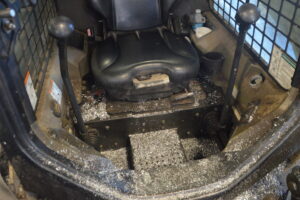 Skid steer vs. compact wheel loader costs
Skid steer vs. compact wheel loader costs
As far as skid steers versus compact wheel loaders, Goldman cites several operating cost advantages. One immediate gain is reduced tire wear
on the expensive solid-rubber tires necessary in scrap yard operations.
“Since it isn’t skidding all day long, the tires should last a lot longer with the articulated steering,” he says. “On our skid steers we’re replacing tires once a year.”
Pasco also had good reason to want a long-lasting machine. Metal scrap yards are some of the most brutal environments a machine can encounter. “We get about five years out of our skid steers, but we should be getting 10 or 12,” Goldman says.
And while compact wheel loaders offer plenty of power, they typically have smaller engines than similar-capacity skid steers. A skid steer puts a lot of its engine power into turning and moving the machine around. The Hitachi compact wheel loader, on the other hand, has an axle, articulated steering, and a differential. This makes maneuvering more energy efficient and frees up additional power for the hydraulics. There’s less load on the engine and as a result, lower fuel use and longer engine life.
A compact wheel loader is initially more expensive than a skid steer, but Goldman says the expectation is that it will be more productive, hold up better and deliver lower operating costs over time.
Small wheel loaders, dependable friends and family, and a central location make Larson Topsoil a premier destination for landscape materials throughout the Tampa Bay region.
In Central Florida landscapers stay busy year-round. To feed their never-ending appetite for materials, Larson Topsoil sells and delivers everything they need in the way of materials mulch, rock, gravel, sand topsoil, potting soil, and shell.
With a small crew including himself, his son and wife and four others, Larry Larson, the company president, dispenses $3-million worth of materials every year using a fleet of small wheel loaders and four Class 8 delivery trucks.
Larson sells to everybody, from homeowners to big outfits, and that means a lot of activity. On any given day they’ll be loading everything from pickup trucks to tractor-trailer rigs. Space is tight in his yard, and the small wheel loaders stay busy.
Visibility and maneuverability
Given this environment, Larson’s latest additions to his fleet, two Hitachi ZW50 loaders, make a lot of sense.
The small wheel loaders’ size (just 5-foot 5-inches wide over the tires) and good visibility work well on a crowded yard. At full reach the bucket pin height (14.5 feet) allows them to load even the tallest haul trucks. And with the company’s offices just yards away from the stockpiles, it doesn’t hurt that the ZW50’s 44-horsepower, Tier 4 Final engines make them the quietest machines on the property.
“In all honesty, I really love the Hitachis. They are sweet machines and they have lots of power.”
– Larry Larson, president of Larson Topsoils
“In all honesty, I really love the Hitachis,” Larson says. “They are sweet machines and they have lots of power.”
Compared to a skid steer, the small wheel loaders’ better visibility is an important factor for Larson. “I’ve known customers in the landscaping business who were hurt on skid steers, one customer got killed by one,” he says. “I wouldn’t have a skid steer in my operation.”
And the benefits of climate control make for happy operators in Central Florida. “When I was ordering the Hitachis, I asked my nephew who works for me if he wanted an open or closed cab,” says Larson. “He said it didn’t matter, but once he got in the closed cab with the AC, he wanted to hug me.”
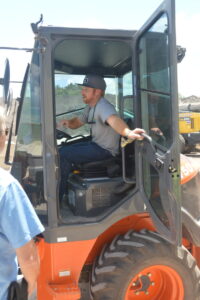 Word of mouth
Word of mouth
Larson’s enthusiasm seems to have spread to other family members. “My brother has a business similar to mine. He bought a Hitachi ZW80, and my brother-in-law bought two ZW80s. Those are open cabs but they bought them pretty much on word of mouth because I liked the ZW50s so much,” Larson says.
And Larson may not be the easiest customer to sell equipment to. “It depends on who shows up and what kind of mood I’m in,” Larson says. Nevertheless, he’s been satisfied in his relationship with his dealer Great South Equipment and the small wheel loaders.
“We had one issue with the loader but they came right out and fixed it. Otherwise, we haven’t had any problems. One loader has about 2,000 hours on it and another is close to 1,100 hours. They’ve been great machines.”
Automotive interests
Like many people who work with heavy equipment, Larson and his son are car enthusiasts. Larry owns a baby-blue ’57 Chevy pickup truck that he had restored and upgraded. His current project is a ’55 Chevrolet Bel Aire, which is undergoing a complete frame-off restoration.
Larson was racing cars when he was 17 and helped his son Justin get started in the sport with the intention of breaking into the ranks of NASCAR. After a few years, Larson realized that NASCAR was going to cost more money than he was comfortable with, so for the time being they’ve backed off on those goals.
“Justin is a marketable kid, and he has talent,” says Larson. “But I didn’t have the $2 million dollars it takes to get my kid a ride with NASCAR. I wasn’t going to mortgage the farm to do that. So I still have two cars but I sold the hauler. And I don’t owe anybody anything.”
Debt free for good reason
Larson’s aversion to debt extends, not just to racing, but to his entire business philosophy. That’s one of the reasons his company weathered the 2008-09 recession with little damage.
“I learned working for my dad, who also had a landscape materials business, to always put some money away for a rainy day,” says Larson. “So, we were able to survive the recession. We slowed down some, but we were still moving right along. We’ve been blessed to keep going. Debt is a real killer.”
And it doesn’t hurt to have a wife who worked in a bank before joining the business. “All she does is save. She never wants to spend,” Larson says, although he means it as a compliment. When asked what’s the number one reason he’s been successful in business, Larson will tell you, “A good wife.”
Location, location, location
Larson has operated out of the same location since starting his business 38 years ago. With access to Clearwater, Palm Harbor and Pinellas Park, landscapers in three counties know it’s easy to get to Larson Topsoil.
“Everything came to us,” says Larson. “Even people further away will drive down to us because we’ve got such a good reputation. And believe it or not, I still sell to customers we had when we started.”
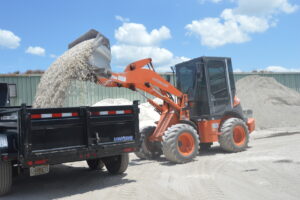 Friends and family program
Friends and family program
Having mostly family and friends of family in the business helps keep Larson Topsoil stable and successful as well.
Finding outside help—people who can drive a truck and run a machine, who will show up on time and work hard—is a struggle for Larson like any other business owner. “I’ve hired some people from the outside but it usually doesn’t work out,” Larson says.
“But Harold in the office, he’s been a family friend for 45 years,” Larson says. “My sister has worked for me from the get-go. My wife left her job to work for us four years into our marriage. Justin has worked for me since his teens and now he’s the general manager. And Aaron Thompson, my nephew, is the yard manager.”
A tight knit crew of family and friends helped bring success to the company. But it also requires flexibility. If you work at Larson Topsoil you do whatever needs to be done, whenever it needs doing, even if you’re the boss.
Some days Larson rarely leaves the office. Somedays he rarely sees it. “Like today, I jumped in a truck and took an order of shell to Oldsmar,” says Larson. “I came back, jumped into another truck, took a load of filler dirt to the northeast section, then came back and jumped into the small wheel loader to pile up a bunch of dirt. Every day is different.”
Black Gold Compost Company relies on Hitachi wheel loaders to keep their compost business moving
If you’ve been in a big box or retail home center store in the past few decades you’ve seen the distinctive black and yellow bags of Black Kow Compost in the garden sections.
Behind those products is an Oxford, Florida-based company, Black Gold Compost, with a long relationship to the wheel loaders of Hitachi and its predecessor, Kawasaki.
Black Gold Compost was founded in 1970. The Lange family bought the company in 1985 and at one point all the brothers and sisters had worked in the business. Today, Michael Lange is the president and one of his sisters still works in the office. The company has gone from producing 50,000 bags of compost in its first year to 6 million last year, and it now offers a diversified range of products such as Black Kow Topsoil, Black Velvet Planting Soil, Mushroom Compost, and the basic Black Kow Mature Manure compost.
And as with so many other home and garden products throughout the COVID-19 pandemic, sales of Black Gold Compost products have boomed. “We’re probably up by 30 or 40%,” Lange says.
 Equipment intensive
Equipment intensive
The Black Gold’s site fills some 120 acres total, with up to eight loaders traversing 80 acres of that. The loaders stay busy, each averaging about 2,000 to 2,500 hours of work a year.
Almost every day, mountains of dry cow manure are hauled in from dairy farms in the region and dumped onto the back of the site. As needed, the manure is loaded into trucks, then laid out in dozens of long windrows. After being mixed by stirring machines, each of the windrows are moved forward by the loaders in a slow march towards the front of the site.
“We compost year-round in Florida,” Lange says. “After all, the dairy cows make manure every day. But because of the seasonality of sales, it may be six months to a year before the material goes into a bag.”
Key machines
Loaders are essential to the process from start to finish and Black Gold’s relationship with Hitachi and before that, Kawasaki, goes back decades. More recently, the company bought two new Hitachi ZW220s to keep up with the growing demand.
“We’ve done business with Great Southern Equipment and Kawasaki from the beginning,” Lange says. “The first loaders we bought in 1985 were Kawasakis. They make up probably 80% of our fleet. They are reliable and they don’t break down. I think the operators like the comfort and the controls.”
For the purchase of the two newest Hitachi loaders the company ran a comparison test with loaders from two competing brands. Hitachi won the competition based on price and two other important factors.
“It seemed like the Hitachis had a lot more power and were more user friendly,” says Jody Futch, general manager. “There wasn’t much difference between these and our Kawasakis, so they were familiar to our operators. For them it’s like riding a bicycle—exactly the same.”
Good maintenance, long life
Looking around the Black Gold site in Florida, you’ll still see several of the KCM branded Kawasaki loaders still running strong.
The company was even recognized by this magazine back in 2014 when it purchased Kawasaki’s first generation of Tier 4 emissions compliant loaders, the Kawasaki 80Z7.
As the loaders age, the company will have Great Southern Equipment rebuild their engines and transmissions to give them a second life. The only regular replacement item unique to the operation is the bucket.
“The Hitachis [have] a lot more power and were more user friendly. They were familiar to our operators.”
–Jody Futch, general manager of Black Gold Compost Company
“Because of the corrosive nature of the compost, we used to have bucket liners that got us to about 5,000 hours,” says Futch. “But our supplier went out of business so we’ve started using a heavier duty bucket and those seem to last a little longer.”
Even the airborne dust is corrosive, so the loaders are pressure washed at the end of every day. “We have a washout station set up and it only takes five or ten minutes,” says Futch. “If you let that material sit on the loader, it will slap eat it out,” he says. Hose fittings, valves and pins are particularly vulnerable.
The corrosion was one reason why Black Gold decided not to put auto-lube systems on their new Hitachis. “The material we were loading was corroding the ends of the lines, so we wanted to try the new loaders without them and just have the operators grease them every morning,” says Futch says.
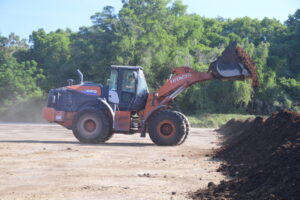 No regens
No regens
Hitachi’s new loaders use selective catalytic reduction (SCR) and a diesel oxidation catalyst (DOC) to reduce emissions. Many other brands of loaders and equipment use diesel particulate filters (DPF) to reduce emissions but these systems also require periodic regeneration—meaning a super-hot blast of fuel is blown through the DPF and out the exhaust system to burn off soot.
The possibility of DPF-based regens causing a fire when a machine is near combustible material is minimal, but not zero. With hundreds of acres of organic material and airborne dust swirling around Black Gold’s site, fire prevention is an important aspect of the operation.
“The Tier 4 Final KCM 80Z7 and Hitachi ZW220s meet the emissions standards without the need for a DPF,” says Steve Tuton, salesman for Great Southern Equipment. “They have DEF fluid and a DOC only, thus no regens. It’s a serious benefit to buying Hitachi, and thankfully, a problem Black Gold does not have to deal with.”
Grooming operators
Mike VanDerTulip, the company’s general manager, is strict with his service protocols. Oil changes and other routine maintenance items are handled at 250 hours. In addition to equipment management, VanDerTulip has operational responsibility for the bagging operations and recently supervised the installation of the company’s first robotic bag stacking arm. Of the nearly 25 employees at the company, six are wheel loader operators, and VanDerTulip has a good way to make sure the operators he does put on the machines will take care of them.
“Our operators are chosen from employees who work in the bagging operations,” VanDerTulip says. “Those are the entry level jobs. If they work hard and show interest, we will move them into a loader operator job when one becomes available. It’s considered one of the best jobs here. We teach them how to run the loaders by having them push dirt and compost on flat ground, then gradually move them to stockpiles. Once they have the skills, we let them load trucks and the hoppers at the bagging plant.”
Good work
The process of turning farm waste into a useful product is good in more ways than one. Lange says his father, who bought Black Gold Compost with a partner in 1985, worked in the agriculture feed industry and had long been aware of the problem dairy farms experience getting rid of their animal waste.
At the time, industrial scale composting was a relatively new industry. But over the years the industry has grown as more people recognize its benefits. It is good for the farmers and good for the environment. It’s also good for consumers and their gardens and landscapes, helping homeowners improve poor soil, grow better vegetables and beautify their landscapes.
“The compost industry today is getting much better at the production and quality of compost,” Lange says. “And all that material is kept out of the landfills.”
Recipe for success
Since composting takes place outdoors, weather is always a challenge. And trucking out as many as 26,000 bags of compost a day requires great logistics
The key, Lange says, is to have good people, good processes and a good product. “Put them all together and it will keep you busy.”
And since loaders are the key to the operation, having good machines and maintenance is also critical for uptime. “We keep our loaders until they won’t run anymore, which can be 30,000 or even 40,000 hours,” says Futch. “But we keep track of everything. Every bucket that loader moves we track to make sure everything is running efficiently.”
Newsweek interviewed the President of Hitachi Construction Machinery, Kotaro Hirano, as the magazine explored the strengths and strategies behind Japan’s world leadership in technology and infrastructure projects.
Hirano’s focus on supply-chain quality helps to explain how our Dash-6 wheel loaders have earned a place in today’s top-tier equipment fleets.
Read Newsweek’s complete article here.
Now is the time to compare Hitachi compact wheel loaders vs skid steers. Both bring versatility and agility to the jobsite and you owe it to yourself to compare before you buy.
In many applications, Hitachi’s award-winning compact models are the right choice for:
- Power
- Safety
- Ease of Operation
- Savings on fuel and tires
DOWNLOAD our helpful comparison guide to learn the differences and make the best choice for your business.
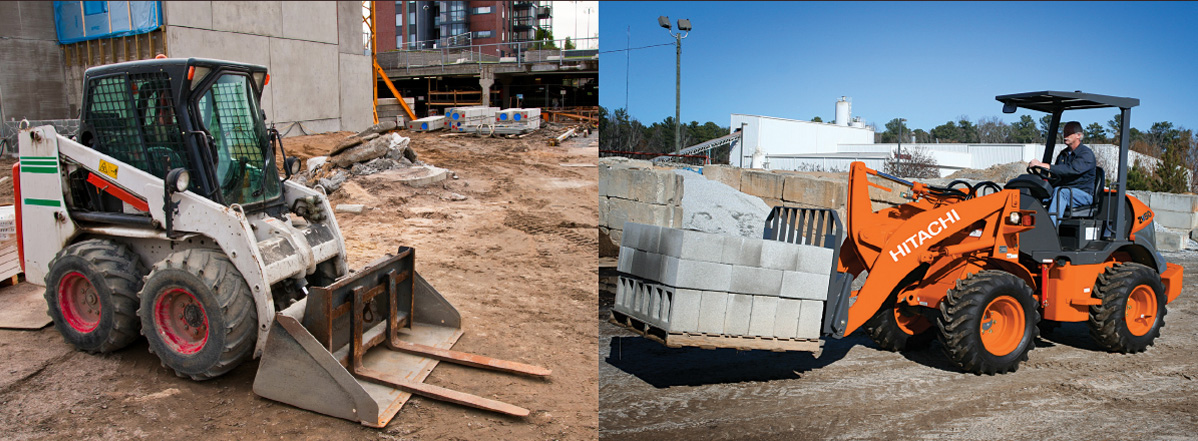
For as long as Petoskey, Michigan, native Robert Drost can remember, families have been making their way north to his little corner of “Pure Michigan.” And who can blame them? The woods, inland lakes, ski hills, streams and Lake Michigan shoreline in and around Petoskey form what is arguably America’s greatest blend of nature.
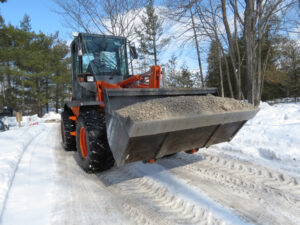 One thing Drost has noticed changing over the years is the accommodations weekenders, vacationers and retirees expect along the Upper West Coast of Michigan.
One thing Drost has noticed changing over the years is the accommodations weekenders, vacationers and retirees expect along the Upper West Coast of Michigan.
They simply demand the best — and Drost Landscape delivers. The company has been recognized eight times by the Michigan Nursery and Landscape Association, winning awards in such categories as residential installation, residential design and installation, residential design/build and residential management.
As a young man growing up in the area, Drost worked on the small farms that then dominated the region. “Landscaping? I didn’t even know what that word meant,” he says. “Seriously, I don’t think many people up here did.” They do now.
“These people come up here to enjoy the lakes and the fresh air, and they will put more money into their homes here than they do downstate,” Drost says. “They trust us, and we don’t take that lightly.”
Drost Landscape has come to rely on good partners to take care of a demanding, high-end customer base in Northern Michigan. Dustin Drost, left, and Robert Drost, center, work with Bill McDaniel of Grand Equipment, the local authorized Hitachi Wheel Loaders dealer.
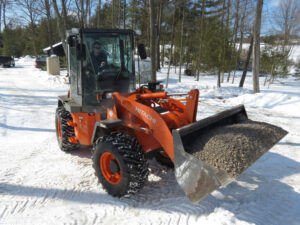 Drost demands the highest standards
Drost demands the highest standards
To deliver the best means being the best and having the best, says the passionate and highly charismatic Drost. The landscaping industry can run the gamut in terms of quality, expertise and performance, but Drost Landscape is a professional organization in the most complete, thorough and strictest definition of the term.
The team grows into the hundreds during peak season, but Drost retains a core full-time staff year-round that includes highly trained and experienced designers, project managers and division managers. Drost credits much of the daily organizational success to Dale Drier, who came aboard in 1997 when the company was about six years old. Now the general manager, Drier is himself a designer who quickly adopted the Drost vision – a mix of traditional service and progressive culture.
“They say no one man does a team make, and that’s really what you see here,” says Drost, known to most people as Bob. “This place is like the hand. You’ve got people who are thumbs, people who are pinkies, people who are index fingers – they all have different attributes. I realized a long time ago it’s not about me; it’s about us. As a team, we can conquer things, and we do. My biggest contribution is a little out-of the-box thinking.”
And, it must be noted, that though he does not operate the equipment, he loves being around it. “I love seeing it, I love learning about it, and I love buying it.” Among the most recent acquisitions is a Hitachi ZW80 compact wheel loader, delivered by Bill McDaniel of Grand Equipment Company, the local authorized Hitachi Wheel Loader dealer, based in Grand Rapids, Michigan.
Hitachi loader earns rave reviews
Replacing a competitive model, the new ZW80 is part of a construction fleet of more than 30 excavators, skid-steer loaders, compact track loaders and wheel loaders. Drost Landscape also owns and operates fleets of trucks, as well as specialized equipment germane to company divisions such as tree service and maintenance
Starting in 1991 with a skid-steer, dump truck and “four guys and myself,” Drost says it’s easy to remain humble. “I remember when we got three pieces of equipment and I thought, there, one for every crew, perfect. And now we run 19 jobs at a time.” It hasn’t taken long for Drost Landscape equipment operators to take note of the 1.2-cubic-yard addition to the loader fleet. “Completely unsolicited, one of the guys said to me just the other day, ‘That new Hitachi is the best loader you’ve got, boss,’” says Drost, whose son Dustin had a similar conversation with the same person. “That operator has grown up around machinery,” says Dustin, a project manager, “and he’s kinda picky, to be honest.”
That operator, Paul Robiadek, works on a crew under supervisor D.J. Hall. Despite it still being the heart of winter, they were busy constructing an outdoor showpiece at a new home near Charlevoix. As well as snow removal, Drost Landscape had about a half-dozen active jobs going in the dead of winter – and that, says Dustin, has been the way for Drost Landscape for the past decade, if not longer
Robiadek raves about the design of the ZW80. He notes the modern exterior sloping and pillarless cab design with floor-to-ceiling glass provide clear visibility all around the machine, “and with a smaller counterweight, you don’t have to worry as much about turning around and hitting something. When you’re in a tight area such as this, you can see all around you and make sure you’re clear.”
At this jobsite, the ZW80 was maximizing its 63 hp of engine output and 8,280 pounds of breakout force to load, move and dump snow, dirt and building materials, as well as to load trucks, which it can still comfortably do at its compact size.
Most impressively, Robiadek swapped out the loader bucket for a fork carriage to move huge rocks to be used in the designed landscape – rocks that average roughly 72 inches by 16 inches by 6 inches apiece and were in some cases being moved two at a time. “All those rocks you see stacked here? I had no problem getting all of them down here from the road, through the trees. The rear tires on that Hitachi loader never came off the ground once,” Robiadek says. “It’s by far one of the best smaller machines I’ve ever operated.” His supervisor and seasoned watcher Hall confirmed the dual rock lifting claim was no exaggeration.
Weighing in at a standard 12,220 pounds, the Hitachi ZW80 is rated to lift and carry loads of up to 3,587 pounds.
A quick loader that is also a quick learn
Dustin Drost, whose brother Travis also works for the company, says the feedback he has received on the ZW80 matches his own experiences. “One thing all the guys have noticed is the power that these loaders have. It’s amazing,” Dustin says. “When you are going a longer distance down the road and are in rabbit mode,
The ZW80 is capable of speeds up to 21.1 mph. “Everyone who operates it is so taken by that,” Dustin says. “And that’s something I noticed right away myself. The first time I operated it, I thought it was moving in rabbit, and I looked down and it was in turtle. Right then and there, I was like, ‘Holy moly.’ Very impressive!”
Aesthetically, the ZW80 is a winner, too. “I like the Hitachi color a lot,” Dustin says. “That Hitachi Orange is really, really nice, because it stands out on site. Yellow often blends in with the sun whereas the orange just pops more.”
On any given day, the nature of the landscaping business is that several different operators may be on a loader, and they find it simple but highly productive,” Dustin says.
Welcome to the family
Robert Drost admits that when McDaniel calls from Grand Equipment, the conversation often goes just about anywhere. Good friends are like that.
The trust that homeowners in and around Petoskey have placed in Drost Landscape is exactly the type of trust he appreciates in the people he does business with. That’s certainly the case with McDaniel and Grand Equipment. “Whatever machine they’re selling, Bill will bring it up just to see if we like it, but it never seems to leave,” Drost says.
It seems that Petoskey’s first Hitachi ZW80 will be keeping busy for some time.
“It’s impressive just how fast this Hitachi loader goes. This one really gets up and goes. Even in turtle mode, it’s quick.”
– Dustin Drost, project manager, Drost Landscaping
This story first appeared in Hitachi’s Q2-2019 issue of FOCUS magazine, also available as a PDF, here on our website.
